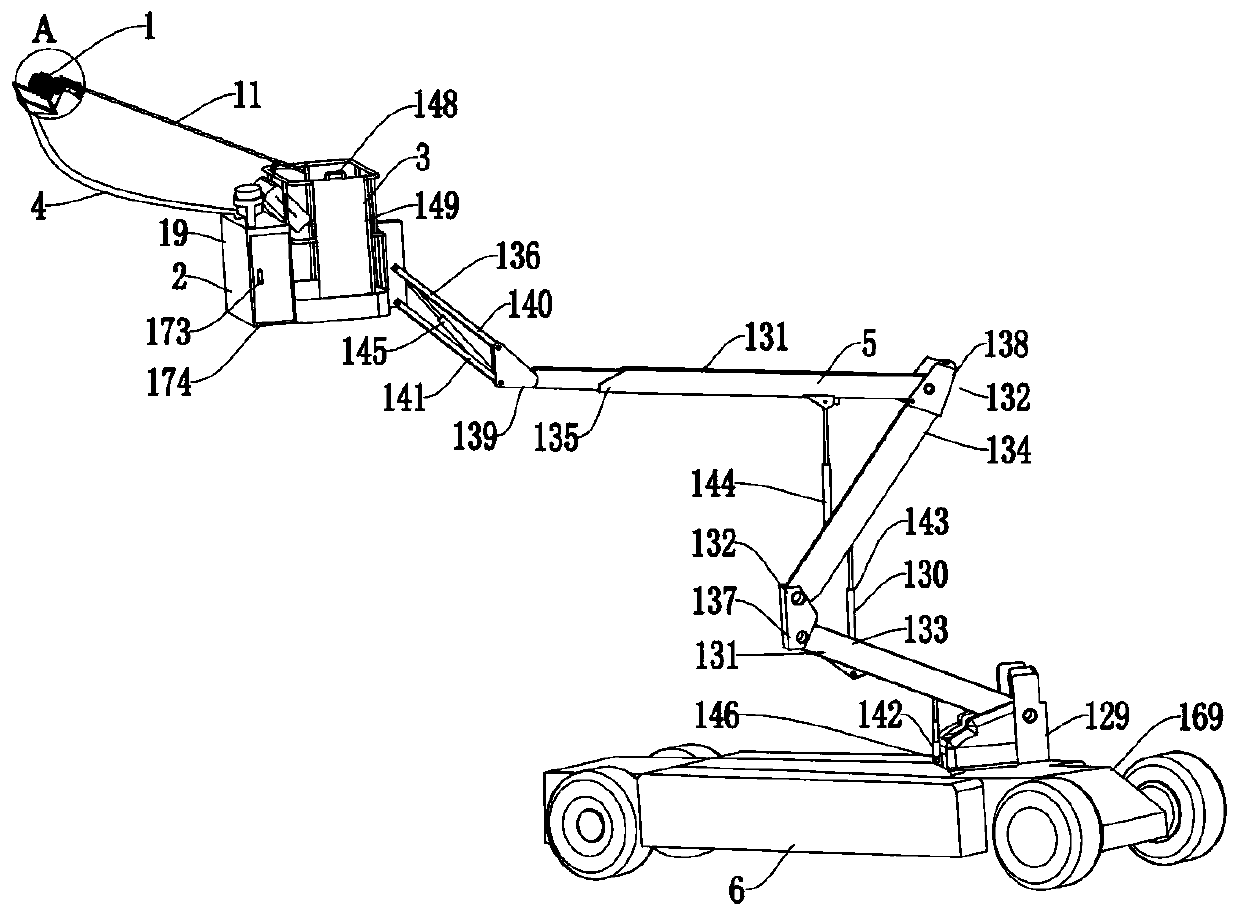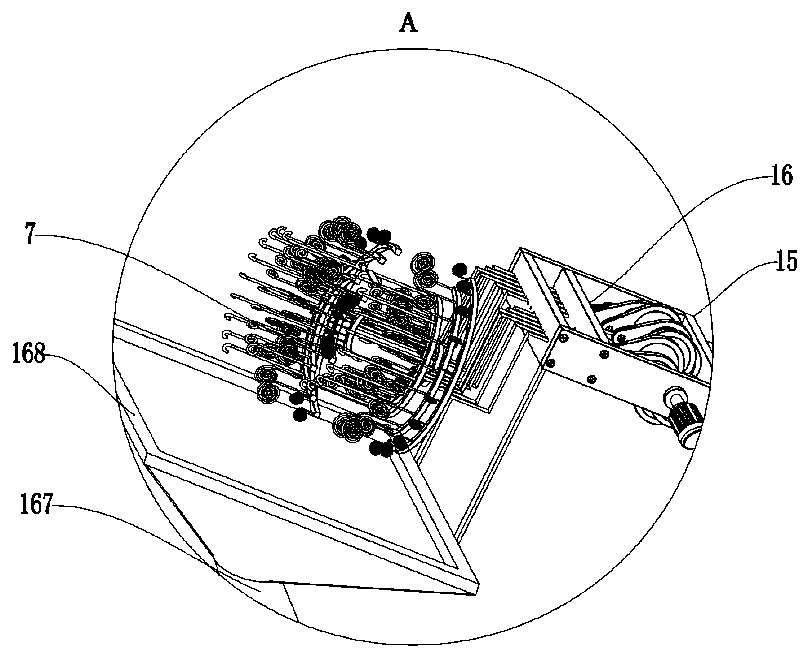[0003]
Hovenia dulcis is a tall tree with a height of 10-25 meters. It can be picked only when the fruit stalks turn reddish-brown after several frosts after the
frost in November in winter.
Hovenia dulcis matures in batches. The current picking is mostly manual picking, mainly direct picking There are two methods: the direct picking method and the high-
branch shearing method. The direct picking method requires pickers to
climb to the tree or pick with the help of a ladder. It is also necessary to carry a loading container, which greatly increases the danger of pickers picking, and greatly consumes the energy and
physical strength of pickers. When pickers
climb to the tree to pick, the Hovenia dulcis tree has a wide crown, luxuriant branches and leaves, and the branches extend outwards. , the growth
terrain of the
fruit tree is complex, and the fruit is very scattered. The pickers may fall from the tree if they are not careful when climbing, and the pickers can only pick the jujubes on the branches close to the
trunk when picking, which is difficult. Jujubes are picked on the top of the tree and on the branches that are far away from the main
trunk and cannot bear the weight. In addition, the pickers are easy to cause damage to the
trunk of Hovenia dulcis during the climbing process, which will affect the results of the next year; After picking Hovenia dulcis, pickers need to look up for a long time to observe the position of Hovenia dulcis, which may easily damage the
neck muscles, and it is difficult to clearly distinguish Hovenia dulcis from branches and leaves due to the too
far distance during picking, and it is easy to damage the branches and leaves of Hovenia dulcis. The blade part of the blade is very sharp and can easily scratch the surface of Hovenia dulcis fruit, making it contaminated with
bacteria and corruption. In addition, holding high-
pruning shears for a long time can easily cause
hand muscle soreness and damage, which is a large amount of labor and low labor efficiency. The color is similar and Hovenia dulcis has luxuriant branches. It is difficult to distinguish the fruit and branches of Hovenia dulcis during manual picking, and it is easy to damage the branches by mistake. When picking manually, because Hovenia dulcis is picked in winter and matures in batches, pickers can only pick a small amount at a time. For the Hovenia dulcis fruit, it is difficult to accurately distinguish the mature Hovenia dulcis from the immature Hovenia dulcis when picking, the picking efficiency is low and it takes a lot of time, and the maturity of Hovenia dulcis will affect the taste of Hovenia dulcis, immature
infructescence axis contains A large amount of
tannic acid will make it sour and dry, making it difficult to eat. Hovenia dulcis with a maturity of 80% or more will reduce the astringency and improve the
flavor, which is very sweet and aromatic. After
ripening in a cool and ventilated place, put them on the market. In addition, in order to ensure the best taste of Hovenia dulcis fruit stems and maximize the farmers’ economy, it is necessary to grade Hovenia dulcis so that they can be packed and sold according to the
transportation distance. The current
processing The main method is to pick Hovenia dulcis and then grade them. It is difficult to accurately judge the maturity of fruits when picking manually, resulting in fruits with different maturity being picked together. Some fruits are not yet ripe when picked, and there is a lot of
tannin in the fruit. , the taste is not good and the medicinal property of Hovenia dulcis is not optimal, which causes great waste to the farmers and is not conducive to the maximization of
economic benefits. In addition, experienced staff need to carefully observe and judge when grading, and it is difficult for existing machinery to achieve The grading of fruit stems of Hovenia dulcis is cumbersome and labor-intensive, with low labor efficiency and high production costs. The infructosis axis of Hovenia dulcis is weirdly twisted, the
flesh is soft and crisp, easy to break, and the
skin of the infructosis axis is extremely thin. When picking by rigid machinery, it is very easy to
bruise or even damage the fruit sequence axis of Hovenia dulcis. It will be broken, easy to be contaminated with
bacteria and accelerate decay, which will affect the value, quality and storage of Hovenia dulcis, causing great losses to farmers, and it is easy to drop when the maturity of Hovenia dulcis is high, because the meat of Hovenia dulcis is brittle and soft It is very easy to be injured or even broken, which will affect the storage of Hovenia dulcis, and farmers need to pick it in time; due to the different uses of fruit stems and fruits, in order to obtain more profits, fruit farmers separate the picked Hovenia dulcis fruits from the fruit stems and then
sieve them separately Packing and marketing, the picked Hovenia dulcis fruits and fruit stems should be separated in time for subsequent
processing. At the same time, the fruit
skin should be removed in time and the seeds should be taken out for
drying. Because the fruit stems of Hovenia dulcis grow in different claws, are multi-branched and not straight, and the
flesh is Soft, brittle and easily damaged, Hovenia dulcis seeds are small in size and grow misplaced at the apex of the branches of the fruit stems. The seeds of the fruit stems are similar in color, some grow on the surface of the fruit stems and some grow inside the fruit stems and are covered by the dislocated and twisted fruit stems. The particularity of the fruiting stems and seeds of Hovenia dulcis has caused great difficulties for the existing positioning elements to locate and separate the seeds and fruiting stems. The existing positioning elements cannot pass through the gaps between the fruiting stems that grow in different claws, are not straight and have many branches. Accurately locate the seeds, and the positioning process is very easy to cause damage to the fruit stalk, and it is easy to cause trauma to the surface of the Hovenia dulcis fruit. , the existing machinery cannot separate it. Currently, it is mainly separated by hand. The existing common manual
separation technology in the market has low efficiency, large labor load, and cannot supply demand. It is difficult for the staff to accurately locate and separate the fruit stalks and seeds of Hovenia dulcis, and it is necessary to carefully separate the fruit from the fruit stalk with a high degree of concentration, especially for the blocked fruits that grow inside the fruit stalk, which are easy to break when separated manually The stalk is broken, and it is difficult for staff without long-term working experience to separate the fruit without damaging the stalk
[0004] At present, there are few machines for picking Hovenia dulcis fruits disclosed in the prior art.
 Login to View More
Login to View More  Login to View More
Login to View More 


